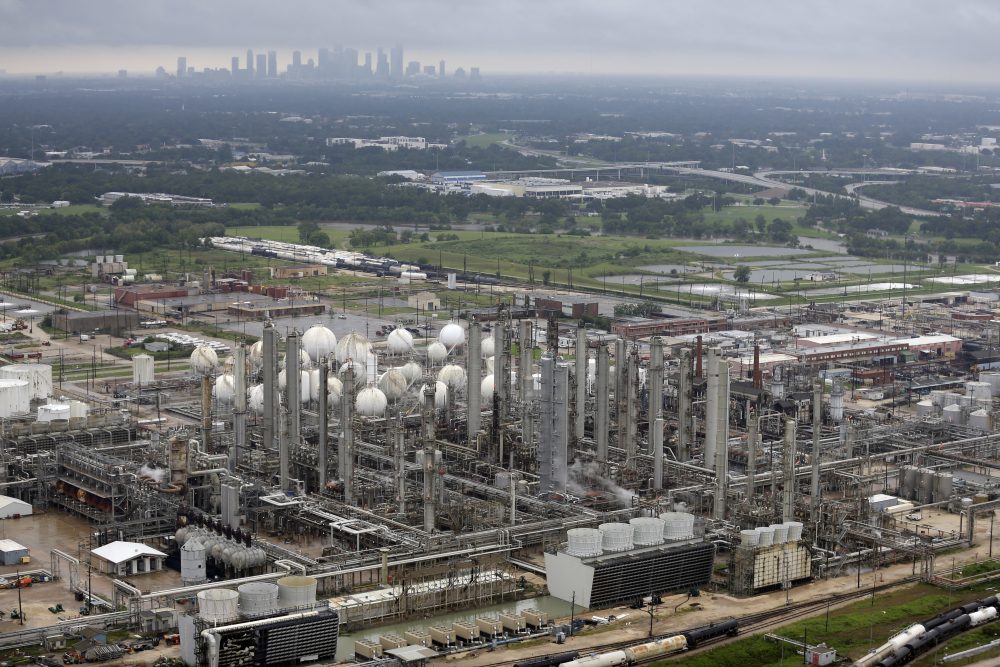New Texas petrochemical facilities are mostly in low income areas, communities of color, study finds
Environment Researchers evaluated the neighborhoods around 89 proposed or expanding petrochemical facilities across the state using a screening tool from the EPA. David J. Phillip/APThis aerial photo shows the TPC petrochemical plant near downtown Houston, background, on Tuesday, Aug. 29, 2017. (AP Photo/David J. Phillip)A recent report from Texas Southern University found that new and expanding petrochemical facilities in Texas are overwhelmingly located in low-income neighborhoods and communities of color. Researchers evaluated the neighborhoods around 89 proposed or expanding petrochemical facilities across the state using a screening tool from the Environmental Protection Agency. They looked at air pollution and proximity to other "hazardous facilities" in the areas. Data related to the race, education, income level and languages within the areas was also collected. Sign up for the Hello, Houston! daily newsletter to get local reports like this delivered directly to your inbox. "The communities that are on the fenceline are getting pollution and they also are getting poverty," said Robert Bullard, one of the study's authors. "And also, if you look at the infrastructures within those neighborhoods that have these facilities, they are of poor quality." The report found that 9 in 10 of the facilities are located in counties with "higher demographic vulnerability" – meaning they had more people of color, more low-income residents, or both, compared to the state and national averages. Over half of the new facilities were slated to be built in communities that have a higher proportion of people of color than the national average. Meanwhile, 30% of the facilities were slated to be built in areas with a poverty rate higher than the national average. "Segregation and racial redlining actually segregated pollution, and it segregated people," Bullard said. The analysis also found that the proposed facilities were being built in areas that are already struggling with air pollution. About 1 in 5 of the proposed facilities are located within the top 10% of areas nationwide with the highest amount of particulate matter pollution, and 46% of the new facilities are slated to be built within the top 10% of communities across the country with the highest amount of air toxins. The facilities were concentrated in 9% of Texas counties, with nearly half of them located in Harris County or Jefferson County.
Researchers evaluated the neighborhoods around 89 proposed or expanding petrochemical facilities across the state using a screening tool from the EPA.
Environment
Researchers evaluated the neighborhoods around 89 proposed or expanding petrochemical facilities across the state using a screening tool from the EPA.

David J. Phillip/AP
A recent report from Texas Southern University found that new and expanding petrochemical facilities in Texas are overwhelmingly located in low-income neighborhoods and communities of color.
Researchers evaluated the neighborhoods around 89 proposed or expanding petrochemical facilities across the state using a screening tool from the Environmental Protection Agency.
They looked at air pollution and proximity to other "hazardous facilities" in the areas. Data related to the race, education, income level and languages within the areas was also collected.
Sign up for the Hello, Houston! daily newsletter to get local reports like this delivered directly to your inbox.
"The communities that are on the fenceline are getting pollution and they also are getting poverty," said Robert Bullard, one of the study's authors. "And also, if you look at the infrastructures within those neighborhoods that have these facilities, they are of poor quality."
The report found that 9 in 10 of the facilities are located in counties with "higher demographic vulnerability" – meaning they had more people of color, more low-income residents, or both, compared to the state and national averages.
Over half of the new facilities were slated to be built in communities that have a higher proportion of people of color than the national average. Meanwhile, 30% of the facilities were slated to be built in areas with a poverty rate higher than the national average.
"Segregation and racial redlining actually segregated pollution, and it segregated people," Bullard said.
The analysis also found that the proposed facilities were being built in areas that are already struggling with air pollution.
About 1 in 5 of the proposed facilities are located within the top 10% of areas nationwide with the highest amount of particulate matter pollution, and 46% of the new facilities are slated to be built within the top 10% of communities across the country with the highest amount of air toxins.
The facilities were concentrated in 9% of Texas counties, with nearly half of them located in Harris County or Jefferson County.

